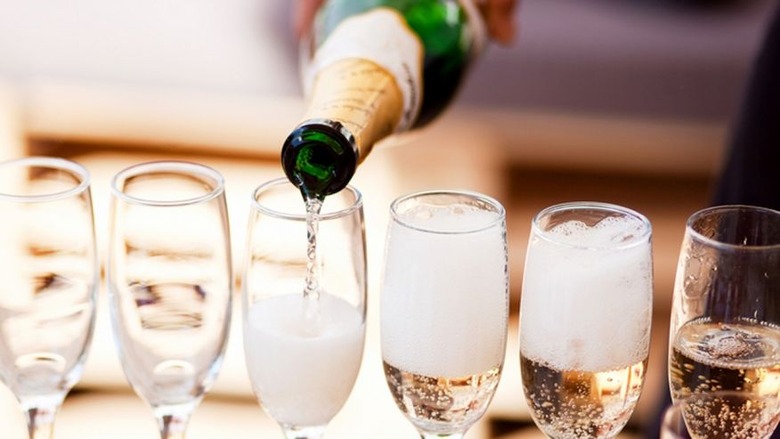The Truth About Champagne
With an impending Champagne shortage due to challenging weather conditions in northeastern France, what's a bubbly lover to do? Stockpile your favorite Champers for later consumption or discover new sparklers (prosecco, anyone?) to enjoy on New Year's Eve?
Before you hit your local vintner, it's important to know what you're getting when it comes to high-end bubbles.
While Champagne and prosecco are both sparkling wines, the similarities pretty much end there. These wines are from different countries, made from different grape varieties and utilize very different production methods and aging regimens.
The Champagne region of France is considered to be the birthplace of sparkling wine and bubbly can only be called "Champagne" if it is from this specific region. Even sparkling wine from another wine region within France must use another name, i.e. a sparkling wine from Alsace must be called "Cremant d'Alsace" – never Champagne.
The highly litigious Champenois have sued well-known brands such as Perrier, Apple and Miller Brewing Company due to unauthorized use of the name. Alternatively, prosecco is from Italy's northern Veneto region and can only be produced in that specific place.
The grape divide
Champagne is made primarily from three different grapes: Chardonnay, Pinot Noir and Pinot Meunier. Prosecco, on the other hand, is made predominantly from the prosecco or Glera grape– but can also contain Pinot Grigio, Verdiso, Pinot Bianco and a few others.
In keeping with the concept of terroir, the aromas and flavors of each sparkling wine will vary greatly depending on where the wine is from, the type of grape variety used as well as the method of production.
New versus old production methods
By law, Champagne can only be produced using the Méthode Champenoise or, as it is more recently known, the Méthode Traditionelle. This time and cost-intensive production method requires that wine's secondary fermentation, the process that gives sparkling wine its bubbles, take place in the bottle the wine is later served from.
Once bottled, Champagne must also be aged for a minimum of 15 months to three years before it can be released. Most reputable houses usually go above and beyond this requirement! In contrast, prosecco is made much differently using the Charmat or "tank" method, which allows the secondary fermentation to take place in a large steel tank. After that, the bubbly is then bottled and can be released on the market for sale after only 30 to 40 days.
The difference in production method results in a significant difference in taste between Champagne and other sparkling wines. While Champagne undergoes secondary fermentation in the bottle, the fermenting wine remains in contact with the dead yeast cells or lees which impart a desirable toasty, yeasty flavor to the wine. Since the Charmat method occurs in a stainless steel tank, prosecco is characterized by crisper, leaner flavors and a lighter body than Champagne.
Why is Champagne so much more expensive than other sparklers?
Champagne usually commands a much higher price than other sparkling wines, but is it really worth it? Sky high vineyard prices, the time-intensive Méthode Traditionelle and a significant post-production aging period all contribute to Champagne's pricey– sometimes exorbitant– price tag. It's usually considered a special occasion only wine but if you're a fan of Champagne's complex flavor profile and appreciate the labor behind each bottle, then what's a few hundred dollars for an out-of-this world drinking experience?
Prosecco's lower price point and less complex palate, on the other hand, makes it a wonderful everyday sparkler and a great choice for using in sparkling wine based drinks such as Sparkling Strawberry Sangria or Pomegranate Rosemary Royale.
Will there be enough bottles to go around in 2017?
Despite the Champagne shortage rumors, Maggie Henriquez, President and CEO of Krug Champagne, says there's no need to worry– yet. "The shortage this year impacts little. The Champagne region not only allows us to make the most beautiful and amazing sparkling wines in the world, but has also developed a number of rules to help houses and growers to go through the weather changes and the whims of nature."
Since blending is a critical part of making Champagne, most houses have an extensive library of wines from past vintages they use to create their wines. These wines can help significantly in tougher years, Henriquez explains.
"In Champagne every year the CIVC, the organization that regulates the Champagne region, announces the...amount of reserve [wines] that can be unblocked. Through the years this self-regulatory, long term sustainable measure allows the houses and growers to have reserve wines to go through tough years. In these short years, unblocked reserve wines can be added to the approved year volume and with this assure continuity and avoid zigzags."
Antoine Collet, Taittinger Champagne Specialist for Kobrand, concurs adding, "While it is true the 2016 vintage will be 20 to 30 percent less than last year, there is nothing to worry about. Champagne lovers can rest assured the Champagne will keep on flowing!"
Cheers to a sparkling start to the New Year.
This article was originally written by Stephanie Miskew and published by FoxNews.com on December 30, 2016.
Stephanie Miskew is a certified sommelier, wine educator and proprietor of The Wine Atelier, an online wine boutique. She also runs the The Glamorous Gourmet, a website dedicated to wine and entertaining.
Related Stories:
